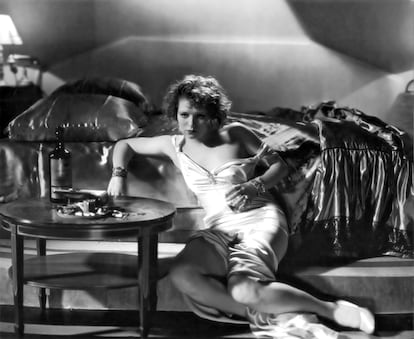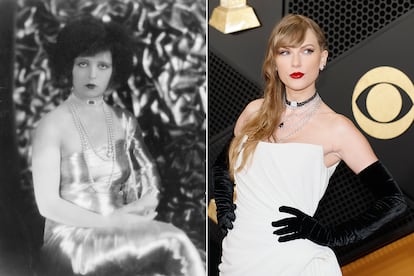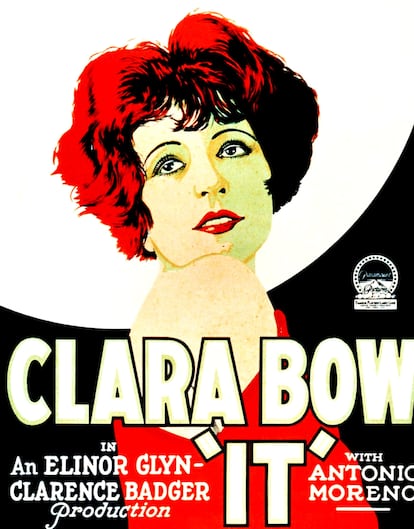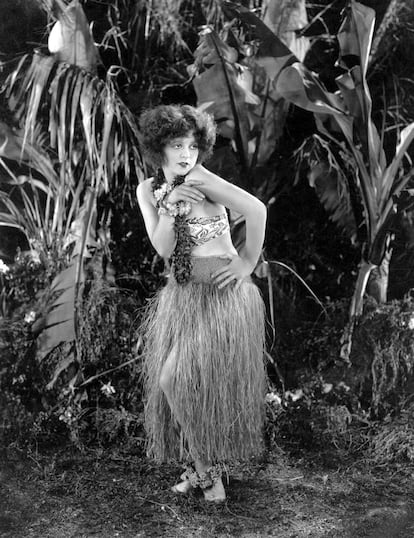Queen of the flappers, retired by 28: the savage life of Clara Bow, the actress to which Taylor Swift paid homage
She grew up amidst abuse and poverty in Brooklyn, but won a contest and became one of the biggest stars of silent film. One of the songs off Taylor Swift’s next album bears her name

“I don’t think I’m very different from any other girl — except that I work harder and have suffered more,” says Clara Bow (Brooklyn, New York, 1905 — Culver City, California, 1965) in the extensive first-person story of her life that Adela Rogers St. Johns — screenwriter, author and one of the most popular journalists of the 1920s and ‘30s, whom communications magnate William Randolph Hearst called “the world’s greatest girl reporter” — published in 1928 in the movie magazine Photoplay. At that moment, Bow was at the height of her career: having come from nothing, she had become one of the great stars of silent film, and had made short hair and lipstick fashionable. Only a year later, she’d shoot Wings, a feature film about World War I aviators that immediately went down in film history by becoming the first movie to win the Oscar for Best Picture at the awards’ founding ceremony, which was held in 1929 at the Roosevelt Hotel in Los Angeles.
But five years later, in 1933, at just 28 years of age, Bow retired.
The actress led a dramatic life. Traumatic experiences in her childhood and youth, gambling excesses (in 1930, she made headlines for not paying a $13,900 bill incurred from blackjack losses at a Nevada hotel) and betrayals (she and her secretary Daisy DeVoe wound up in court, where DeVoe took pains to air out Bow’s dirty laundry) figured alongside epic romances (from Bela Lugosi to Cary Grant and Victor Fleming), overwhelming professional success, a highly influential personal aesthetic and a magnetism lauded by Dorothy Parker and Elinor Glyn. That magnetism has not been forgotten. Margot Robbie took inspiration from Bow in Robbie’s creation of the sparkling Nellie LaRoy in Babylon, the 2022 film by Damien Chazelle (La La Land) about the golden age of Hollywood. In a recent plot twist, Bow is back in the news. Her name is the title of one of the tracks on Taylor Swift’s next album, The Tortured Poets Department, which comes out April 19.

“Who is Clara Bow?” is the question that many a Swiftie has been asking on TikTok ever since, speculating on the track’s content. It’s become clear that the actress has served as inspiration for Swift: her Grammy styling, in a Schiaparelli dress, emanated classic film diva vibes, and diving into the photo archive, fans found a circa 1925 image of Bow in which the parallels are undeniable. Same deep red lips in a Cupid’s bow, a similar set of necklaces, strapless neckline and side-parted hairstyle. And it seems that Swift’s Bow fixation is nothing new: Bow’s star on the walk of fame is located at 1500 Vine Street, on the corner of Sunset Boulevard, and Swift’s legions of fans have made the connection with a verse from her single Gorgeous (off the 2017 album Reputation): “Whiskey on ice, Sunset and Vine.”
What story will the multi-award-winning songwriter want to tell about the golden Hollywood diva on the song Swift named after Bow? If it’s inspired by Bow’s life, all signs point to tragic lyrics. “More than any other woman entertainer of her time, Clara Bow perhaps best personified the giddier aspects of an unreal era,” read the front page of The New York Times on September 28, 1965. Her obituary occupied prime real estate in the paper of record, alongside a photo. And this, even though for decades, since 1931, when she married cowboy film star Rex Bell (The Man From Arizona, Tombstone), she lived a life far from the flashbulbs in the Mojave desert, on The Walking Box Ranch, which is now nominated for inclusion on the National Register of Historic Places. “The remote mystique of the southern Nevada desertscapes are exactly what captured the attention of Hollywood stars Rex Bell and Clara Bow in early 1930s, who craved solitude and a way of escaping the rat race,” states the Travel Nevada website. Bow had to get away from it all, live in the middle of nowhere, to escape her own fame: she used to receive 45,000 fan letters a month.

Truly, she had built a legend. In Photoplay, she told in great detail of her sad childhood in Brooklyn. Her parents were poor; she had two sisters who died shortly after birth, one after only two hours of life and the other, two days; at school, the other girls teased her and called her “tomboy;” her best childhood friend Johnny died in a fire. “His clothes had caught and were burning and he was screaming with pain and fright. When I came tearing in Johnny screamed ‘Clara, Clara, help me.’ He ran over and jumped into my arms,” she recalled in the article. (When she started acting, she was said to draw on that memory in order to be able to cry authentically on camera.) But she remained determined. Bow decided to become an actress, and succeeded when she entered a contest called Fame and Fortune in 1921, when she was 16. Her mother, Sarah, was fervently opposed to the idea, but her father, Robert, supported her mission. “He gave me a dollar. I knew, even then, what a sacrifice it was to him. I went down to a little cheap photographer in Brooklyn and he took two pictures of me for that dollar. They were terrible. Without daring to tell mother, I sent them in to the contest. And sat down to wait and pray.”
The prayers, and Bow’s magnetism, worked their magic. She received a call back and showed up for the pageant casting in an old wool dress and red tam-o’-shanter. She felt out of place as soon as she stepped into the office, surrounded by other hopefuls who side-eyed her. “Suddenly one of the men said, ‘There’s an interesting face — that kid with the red tam and the gorgeous eyes.’ I looked around. I was the only girl with a red tam. Me-Me-little Clara Bow.” Soon after, powerful producer B.P. Schulberg bet on Bow, giving her a three-month contract for $50 a week. She moved to Hollywood, and in 1922 got her first film credit for Beyond the Rainbow, although her role was cut. From that point on, she never stopped working (in 1924, she appeared in seven films; in 1925, 15). Her career was taking off and she was having fun, but this success only served to mask her traumas. Her biographer, David Stenn, author of Runnin’ Wild, writes that her father raped her when she was 16, although she always defended him, and took him to live with her in Los Angeles after her mother’s death in 1923. Sarah Bow had suffered mental breakdowns and even attempted to murder her daughter, the actress told Rogers St. Johns. “I saw mother standing there, in a white nightgown. Her hair was braided over each shoulder and hung down to her knees. In her hand was the butcher knife. I said, ‘Mother?’ She didn’t answer. Just came closer to the bed. […] ‘I’m going to kill you, Clara.’ She said very quietly. ‘It will be better.’ She put the knife at my throat.”

Bow herself dealt with mental health problems throughout her life. She was the epitome of the flappers, the daring women of the jazz era that Francis Scott Fitzgerald talked about in his books, immortalized as Daisy Buchanan in The Great Gatsby, his 1925 novel. Like Zelda, the writer’s wife, Bow was diagnosed with schizophrenia and was interned in various institutions before she died of a heart attack at only 60 years old. “She had her moment in the sun, but even at the height of her popularity she was an outsider,” wrote Playboy’s Hugh Hefner, executive producer of the 1999 documentary Clara Bow: Discovering the ‘It’ Girl, in the Los Angeles Times. Another outsider, singer Courtney Love, narrated the film. It hasn’t been the only documentary that has explored her life. Bow has never ceased to fascinate us: Elaine Shepherd produced the 2012 Clara Bow: The Original ‘It Girl’ for BBC. “The studios were working her to death. She was on heaps of primitive pills to get her out of bed in the morning and to get her to sleep at night. Executives were trying to exploit her as much as possible, gossip magazines were writing the most awful lies about her, and she was dealing with all that on her own, as a woman in her twenties,” described Shephard in an interview.
Bow rebelled against their control, and eventually decided to break free. In 1927, she was christened the original “it” girl when she starred in the film It, by Clarence G. Badger and Josef von Sternber. Bow played Betty Lou, a department store clerk in love with her boss, but separated from him by her social class. She was an icon of fashion and beauty, and her influence went far beyond the movies. It’s been said that Max Factor created a long-lasting lipstick for her, which gave birth to the Cupid’s bow lip shape that triumphed in the 1920s; the makeup icon was even commissioned from time to time to make Bow up on set. Bow was also one of the bob haircut’s greatest champions, along with Louise Brooks and Marion Davies.

She was the flapper, the it girl, but she grew tired of both personas, in addition to the roles that were being offered to her. “She was unable to break from the profitable romantic comedies that kept the fans coming to see her, even through the Great Depression. Her first talkie, The Wild Party in 1929, was a success; her career was not doomed despite her Brooklyn accent, unlike several stars who couldn’t make the transition. Bow went on to make more talkies which did good business, like Dangerous Curves and The Saturday Night Kid, both in 1929, and True to the Navy (1930), but she had great anxiety about doing them, and the first signs of the mental illness that would plague her the rest of her life were breakdowns throughout the filming of the talkies,” explains her entry in the “Forgotten Hollywood” series on the Golden Globes website.
She left the big screen, the glamorous dresses and the glittering roles, had two daughters with Bell — “Not many mothers have had exactly the same experiences. I’m pretty sure no other mother has had mine or anything like it. […] I take this very seriously. All my life I have wanted to have a baby and now that I’m going to have one, I realize I have to be very careful what I do with it — especially what I say to it,” she explained in a magazine interview when she was pregnant with her first son, who was born in 1934. Starting in 1932, she made few public appearances. Her time in the public’s eye had passed, those dizzying years that she had devoted to acting. On-camera work had been her refuge, the only way the girl who had been called “tomboy” during her Prospect Heights childhood could manage to survive. Bow was always aware that glitter could cover any misery that lay underneath. “There is only one thing you can do when you are very young and not a philosopher, if life has frightened you by its cruelty and made you distrust its most glittering promises. You must make living a sort of gay curtain to throw across the abyss into which you have looked and where lie dread memories.”

Sign up for our weekly newsletter to get more English-language news coverage from EL PAÍS USA Edition
Tu suscripción se está usando en otro dispositivo
¿Quieres añadir otro usuario a tu suscripción?
Si continúas leyendo en este dispositivo, no se podrá leer en el otro.
FlechaTu suscripción se está usando en otro dispositivo y solo puedes acceder a EL PAÍS desde un dispositivo a la vez.
Si quieres compartir tu cuenta, cambia tu suscripción a la modalidad Premium, así podrás añadir otro usuario. Cada uno accederá con su propia cuenta de email, lo que os permitirá personalizar vuestra experiencia en EL PAÍS.
¿Tienes una suscripción de empresa? Accede aquí para contratar más cuentas.
En el caso de no saber quién está usando tu cuenta, te recomendamos cambiar tu contraseña aquí.
Si decides continuar compartiendo tu cuenta, este mensaje se mostrará en tu dispositivo y en el de la otra persona que está usando tu cuenta de forma indefinida, afectando a tu experiencia de lectura. Puedes consultar aquí los términos y condiciones de la suscripción digital.
More information
Archived In
Últimas noticias
Welcome to the post-religion era: The idea of Christianity as the absolute truth has become obsolete
‘I thought you would like it’: The risky sexual practice popularized by TV shows and TikTok
The digitalization of tourism: ‘They promise experiences and gave us the worst possible one’
Mexican peso defies uncertainty with forecasts of a new period of stability in 2026
Most viewed
- Sinaloa Cartel war is taking its toll on Los Chapitos
- Reinhard Genzel, Nobel laureate in physics: ‘One-minute videos will never give you the truth’
- Oona Chaplin: ‘I told James Cameron that I was living in a treehouse and starting a permaculture project with a friend’
- Why the price of coffee has skyrocketed: from Brazilian plantations to specialty coffee houses
- Silver prices are going crazy: This is what’s fueling the rally











































